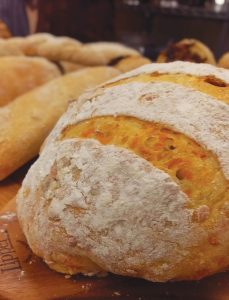 By Paul Suplee,
By Paul Suplee,
MBA, CEC, PC-3
I love watching new students knead bread for the first time.
There they stand at their station, twisting and turning, sweat on the brow with overworked aching shoulders, despite the fact that I have reminded them time and again that the tiniest grandmothers do this with little effort.
They don’t listen to me. They gnash their teeth, blow out their shoulders and biceps and curse the day that I ever dared ask them to knead 14 ounces of flour and water. Who in the hell do I think I am?
It’s all in the technique, I remind them. Roll with the bread. Don’t use muscle, but rather your body weight. Be one with the bread. Blah, blah, blah.
I can tell them until I’m blue in the face, but do they listen to me? No. They hurl themselves into a fit of dough-induced rage and then try to claim workers’ compensation.
So, what if there was a way to make bread without all of this nerve-damaging, spine-crushing work that we coin “kneading”?
If only there was a manner in which we could go through the process without actually going through the process.
It would be akin to participation trophies, only with a much more delicious and dentally forgiving end-product: Bread.
If you are online, and let’s face it, it is sort of difficult not to be, then you have seen the plethora of recipes and videos on no-knead bread. Good lord, they’re everywhere, and they are relentless.
I have ignored them for a couple years yet always wondered whether they had any validity. They can’t be real, can they?
Being an instructor who has preached the hydration of gluten for many years, I had never until this week made no-knead bread. Suffice it to say, I can never say that again, or at least until I age and forget that I had.
Those days have passed. Yes, ladies and gentlemen, I have indeed made no-knead bread and it was rather delicious and incredibly simple.
But seriously, you want me to make something overly simple? You want me to mix a bunch of goo in a bowl, let it sit for hours and then plop it in the oven? Only five ingredients?
You must be joking. I need action! I need involvement! I need … Oh, never mind.
At the end of the day, there is no joke here. It works, and it is a decent loaf of bread, to boot. The secret is in the sitting, something that I am certainly not used to.
When gluten (the protein in bread that is created from the combination of glutenin and gliadin) is worked hard with water (traditional kneading) it breaks down the gluten in a way that allows it to become hydrated through the process. This is why kneading is so important in most standard bread-making.
However, if you simply mix the ingredients and allow them to sit long enough, the same effect will take hold and the gluten will hydrate just the same.
It just takes a lot longer for all that moisture to seep into those rascally little molecules, or bits or whatever they may be in scientific lexicon.
At the end of the day, you have hydrated dough, and that is the point of this entire exercise.
For someone like me, I enjoy the smell and feel of bread as it is being kneaded. I love knowing when there is not enough water, or when there is too much.
It is something that comes with practice. It is something that makes bread making near and dear to my heart.
But I’m not going to lie. No-knead bread is pretty bad-a** Not sure if I can say that in this paper, but there it is.
And only 5 ingredients? Don’t be that new baking student. Just mix, binge-watch a Netflix show, drink a Manhattan and then throw your bread in the oven about 5 hours from now. You’ll thank me later.
No-Knead Bread
Makes 1 boule
3 c. High-gluten flour
1 1/2 c. Warm water, not over 105 F
1 tsp. Active yeast
1 1/2 tsp. Salt
1 c. Aged cheddar cheese
- Five ingredients, and a world of wonder awaits you at the end. Simply combine everything in a bowl and mix with a spoon until it comes together. It will be a fairly loose dough.
- Allow to sit on the stovetop for at least five hours, covered, and it will double in size, if not triple.
- Place some flour on the table and turn the dough out on it.
- Gently form the dough into a ball, ensuring that the seams are on the bottom.
- Place this into a preheated Dutch oven (place it in an oven that you have preheated for about 40 minutes to 450F) that is well sprayed with pan coating.
- Bake with the lid on for about 20 minutes, and then remove the lid, baking it until the bread has a lovely crust and an even more admirable crumb on the inside.
- If you want to be a nerd about it, you can bake it until it has an internal temperature of around 190F.
- Remove and allow to rest for at least 15 minutes; enough so that you don’t burn the remaining fingerprints from your hands.
- Slice and serve as you would any other delicious bread.
— Paul Suplee is the owner of
boxcar40, boxcar on main,
boxcar crafted events and|
sportfish catering.
www.boxcarrestaurants.com
